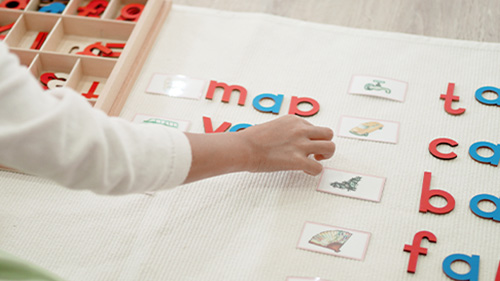Literature Circles with Multilingual Learners
Walk into a middle school classroom during a lively literature circle and you’ll hear questions, laughter, debate, and—most important—learners...
AP & Honors Mathematics
Explore Wiley titles to support both AP and Honors mathematics instruction.
Literacy Skills & Intensive Reading
Connections: Reading – Grades 6–12
Empower student success with a proven intensive reading program that develops strong reading skills in striving readers.
Drama, Speech & Debate
Basic Drama Projects 10th Edition
Build students’ confidence and competence with comprehensive, project-based theatre instruction.
Literature
Connections: Literature
Support learners as they study dynamic, relevant texts and bring the richness of diverse voices to students through literature.
Literature & Thought
Develop critical thinking, reading, and writing across literacy themes, genres, historical eras, and current events.
Language Arts
Vocabu-Lit® – Grades 6–12
Help students build word power using high-quality contemporary and classic literature, nonfiction, essays, and more.
Connections: Writing & Language
Help students develop grammar, usage, mechanics, vocabulary, spelling, and writing and editing skills.
Reading/English Language Arts
Measuring Up to the English Language Arts Standards
Incorporate standards-driven teaching strategies to complement your ELA curriculum.
English Language Learners
Measuring Up for English Language Learners
Incorporate research-based best practices for ELLs with an approach that includes a focus on language acquisition strategies.
Mathematics
Measuring Up to the Mathematics Standards
Incorporate standards-driven teaching strategies to complement your mathematics curriculum.
Foundations
Measuring Up Foundations
Help students master foundational math skills that are critical for students to find academic success.
Science
Measuring Up to the Next Generation Science Standards
Give students comprehensive NGSS coverage while targeting instruction and providing rigorous standards practice.
Assessment
Measuring Up Live
Deliver innovative assessment and practice technology designed to offer data-driven instructional support.
For a better website experience, please confirm you are in:
2 min read
Dr. Almitra Berry May 27, 2024 2:11:00 PM

In my last post, I shared the success stories of two of my multilingual learners. I told you I used strategies, but I didn’t share which ones.
I thought when I got my first language development specialist credential, I had adequately prepared myself to provide quality instruction to my multilingual learners.
I was wrong.
When I got my cross-cultural language acquisition and development credential, I just knew that was the ticket!
Nope.
So, I dove in again and got a bilingual credential. Certainly, being able to read and write and have a greater depth of understanding of Spanish – the primary language of the majority of my multilingual learners – was the missing piece.
Wrong again.
It took years, years of continuing education, of trial and error, of research and practice. YOU shouldn’t have to work that hard. Your learners need you to become an expert, like… now!
In this post, I’ll provide you with five strategies you can use in your classroom today. You’ll find these strategies embedded in the instruction for emergent bilingual learners in Connections: English Language Arts. You’ll find many more in my upcoming book, Equitable Classroom Practices for Culturally and Linguistically Diverse Learners.
Remember, building vocabulary is not about memorizing the definitions of 20 words each week. For learners to build their lexicons, to develop the ability to analyze, synthesize, or evaluate based on their understanding of a concept, they must have at least 36 meaningful interactions with that word or concept.
While multilingual learners greatly benefit from these strategies, remember:
There are multilingual learners whose primary language is English, just not the English of the classroom.
Use these strategies with all learners. Make them a part of your instructional repertoire.
Dr. Almitra L. Berry is an educational consultant, author, and podcaster. She is the emergent bilingual consultant for Connections: English Language Arts. Dr. Berry extensively covers multilingual learners in her book Effecting Change for Culturally and Linguistically Diverse Learners and several Educational Equity Emancipation podcast episodes.

Walk into a middle school classroom during a lively literature circle and you’ll hear questions, laughter, debate, and—most important—learners...

In American K-12 public schools, English language learners (ELLs) make up over 10% of students. 10% may not sound like much, but that’s over 5...
.jpg)
Congratulations! You’re well into the first semester now. You’re developing new and solid relationships with your learners and creating a classroom...

When I think about the success stories of my middle school emergent bilingual learners, I can’t help but smile. What about you? Sure, there were...

The summer break is winding down, and soon you'll be setting up your classroom for another year of learning adventures. Whether you're a first-year...

Do you ever have one of those days where you ponder, “What on Earth am I doing, and am I doing it right???” I did. Often. And they were often...

As middle school educators, we know the moment when a learner comes alive in class. Maybe they're debating a character's motivation or crafting a...

Creating a sense of belonging at school is essential for every student, but it is especially impactful for those with disabilities. Students with...

Transitional literacy focuses on bridging the gap between basic reading skills and more advanced literacy skills necessary for success during middle...

Join Dr. Almitra Berry (A L Berry Consulting) to learn about intentional text selection for ELA Learners in this informational webinar.

Join Dr. Brandon Abdon and special guest Melissa Alter-Smith, founder of #TeachLivingPoets, to explore common-sense approaches to help even the most...

I must have convinced you of the need to build a classroom community from my first post because…you’re here. Or maybe you already know that you need...
